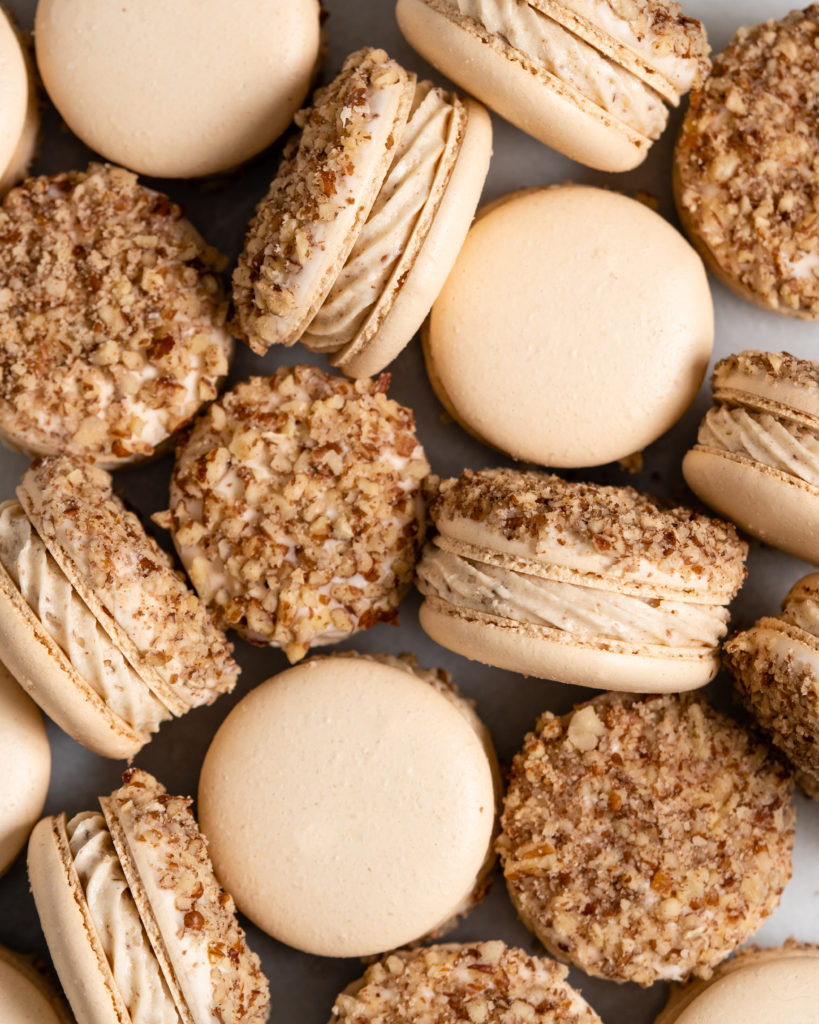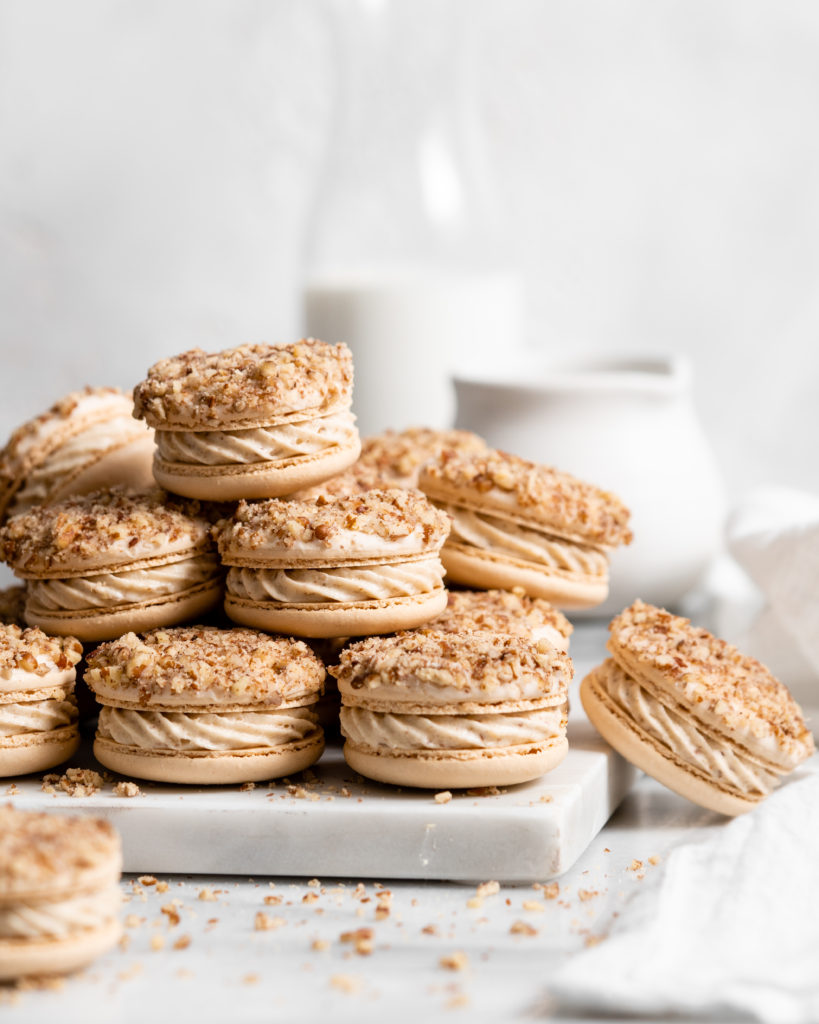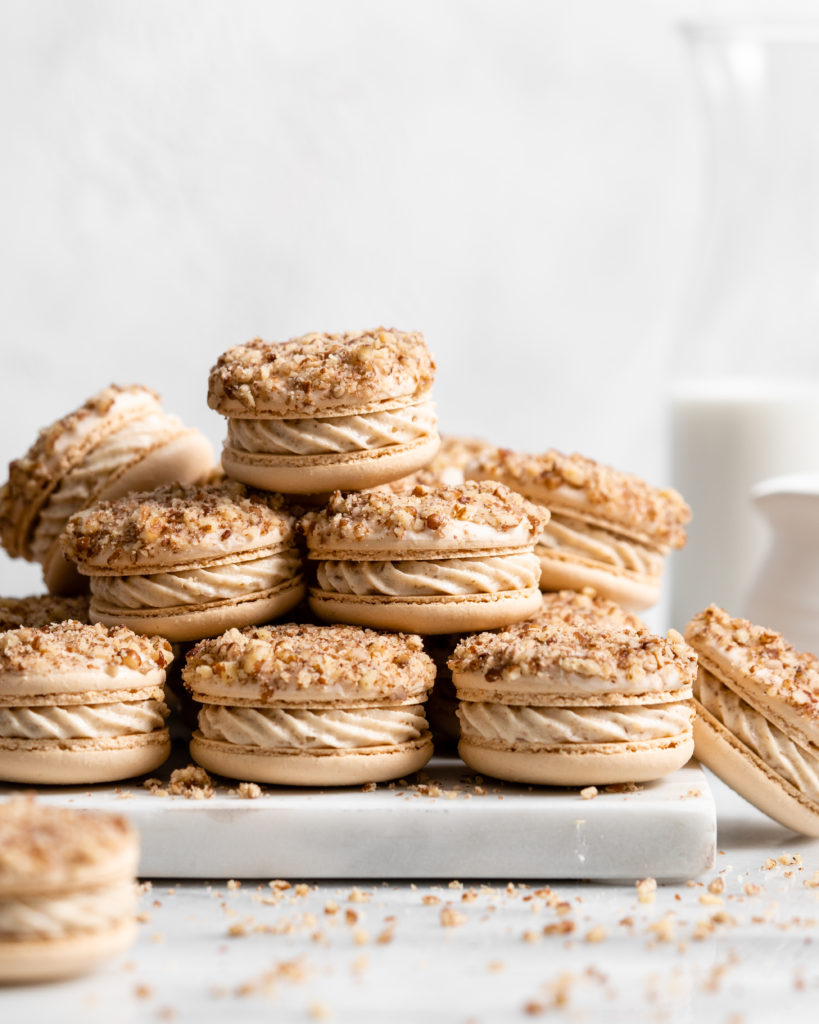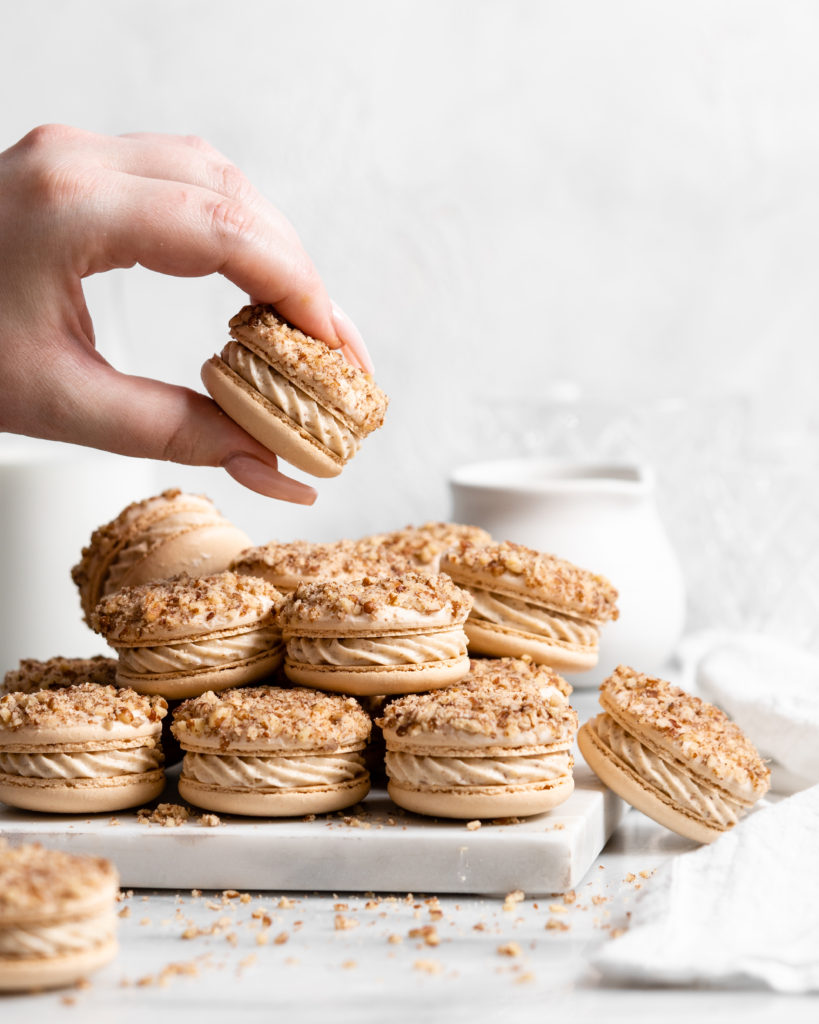Maple Pecan Macarons
This recipe for Maple Pecan Macarons is the perfect fall flavored little treat! Filled with rich maple flavor, the macarons also have a maple buttercream that is speckled with little pecan bits, and a pecan crusted top!
updated (photos, tips, links): November 2020
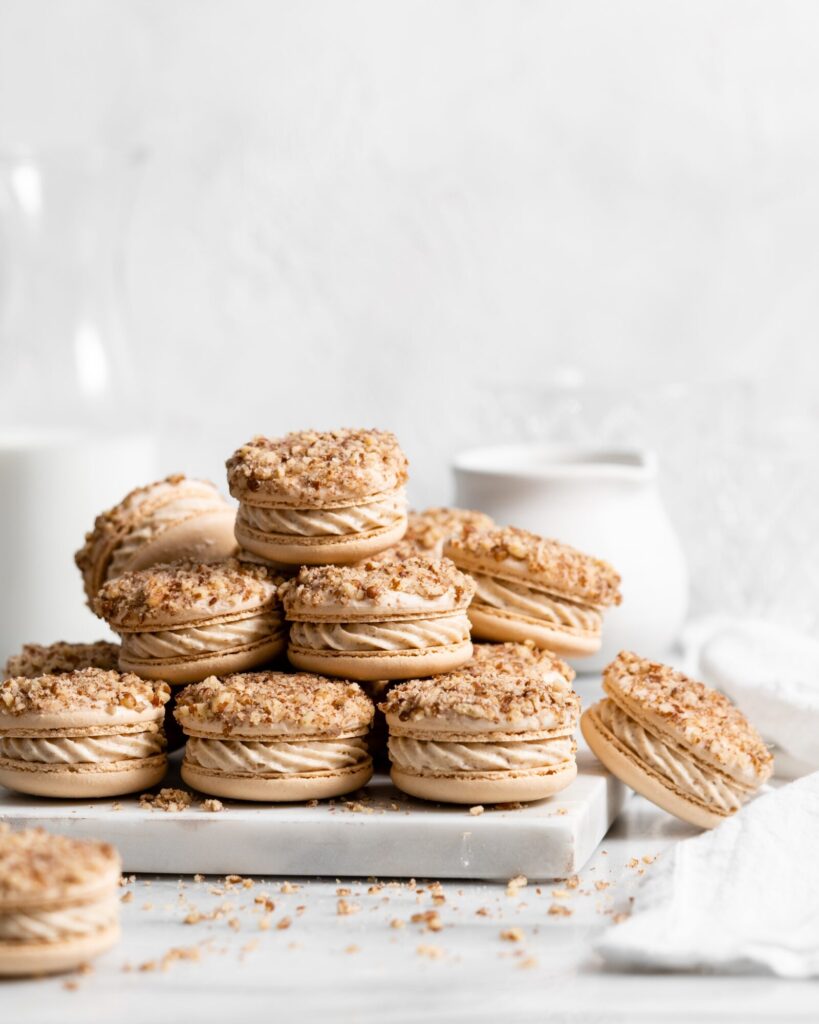
Swiss Meringue Macaron Method
The swiss method for macarons creates a meringue is quite stable and easier to work with in comparison to French macarons!
The Swiss meringue method for macarons involves heating the egg whites and sugar over a bain marie until it reaches the proper temperature. The hot egg whites and sugar are then beaten into a stiff meringue. Finally combined confectioners sugar and almond flour are folded in during the macaronage process!
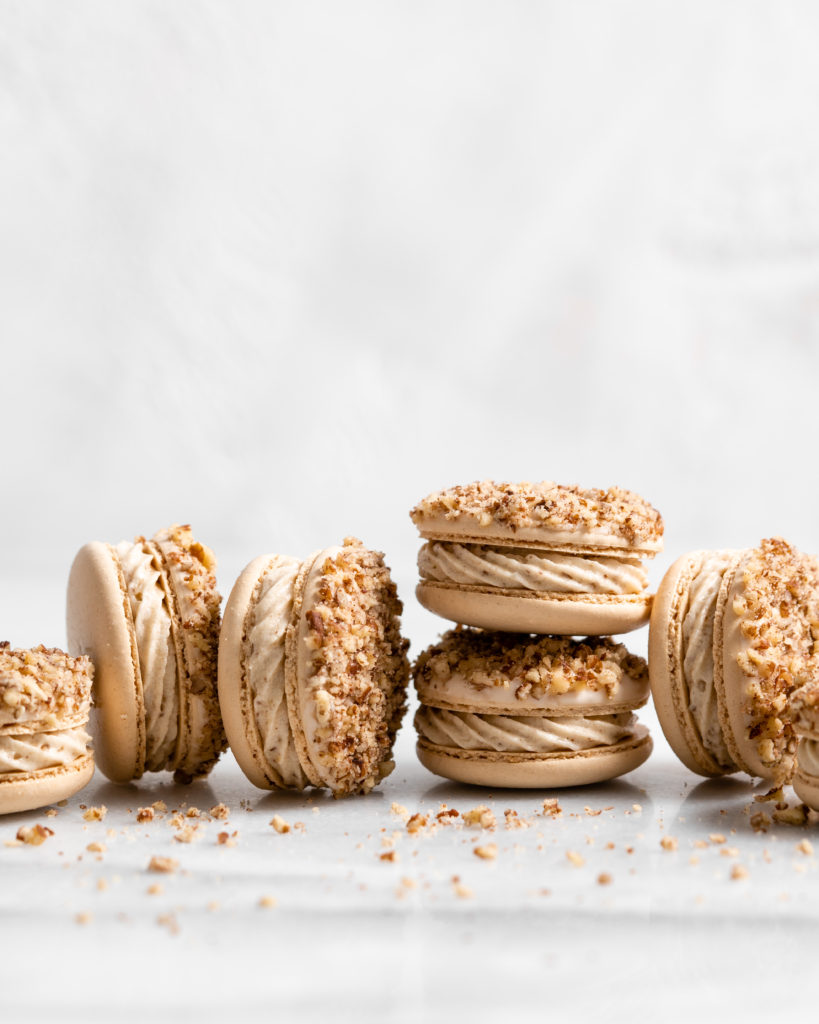
Tips & Tricks for Swiss Meringue Macarons
I have included some of tips & tricks for the swiss meringue macaron method:
Tip 1) Use a food scale and weigh everything out
It is critical that you measure out your macaron ingredients by weight! Macarons have a very low tolerance for error. Volumetric measurement can result in a HUGE variance in the amount of ingredient used. So for something as finnicky as macarons, it is better to be precise, down to the exact gram, with the measurements.
Tip 2) Wipe all utensils/bowls/apparatus with vodka or vinegar
Wipe anything that will be coming into contact with the egg whites with vodka or vinegar. This is to ensure no oil residue is present that would ruin your meringue!
Tip 3) Use Egg White Powder
I found adding egg white powder to the eggs and sugar made for PERFECT macarons! If you ever struggle with hollows – this is the trick for you!
Tip 4) Beat meringue to stiff peaks:
I have found the Swiss meringue macaron method requires the meringue to be beaten to stiff peaks. Stiff peaks means the meringue completely holds it’s shape and stands up straight when you lift the beater up. When looking in the bowl, the meringue should also be gathering inside the whip attachment.
Tip 5) Stop folding once the batter ‘ribbons’
When the macaronage process is complete, the batter should flow like lava, and ribbon off your spatula. If it falls off in chunks it is under-mixed, and if it runs right off the spatula without ribboning, it is over-mixed! The ‘ribbons’ of batter should disappear completely into the rest of the other batter within 30 seconds.
Tip 6) Tap the pan and remove air bubbles
Smack the pan against counter, rotate 90° and smack again, continue until all sides have been smacked. Alternatively, lift the pan up and drop it down onto the counter a few times. This has two purposes, the first being that is causes any air bubbles in the macarons to rise to the surface and pop – resulting in smoother and more stable macarons, and the second being that it causes the batter to flatten out along with any humps left over from piping.I usually smack mine more than 4 times. I just do it until I feel like all the air bubbles have surfaced and the batter has flattened nicely.
Tip 7) Use a toothpick to ‘pop’ any remaining air bubbles
Get up close and personal with your beautifully piped little macs and look for any remaining air bubbles. You are looking for any obvious ones, but also some hidden ones that may just look like a very slight irregularity on the surface, or even a tiny bump. Then use a toothpick and simply pop them, and lightly use the toothpick to swirl batter to fill the hole. I find if I skip this step I can sometimes be left with hollow macarons, so it is definitely important!
Tip 8) Allow the macarons to form a “skin”
This is crucial – I repeat THIS IS CRUCIAL. Do not skip this step whatever you do! This step allows the macarons to rise vertically and reduces the amount that it will spread out horizontally, leading to the oh-so-perfect little feet we’re after! The skin will form faster in cold dry climates, and conversely will take longer to form in hot humid climates. I live in the Prairies in Western Canada (relatively cold and very dry climate) so my skin forms in about 8-10 minutes, while someone living in a less dry climate may have to wait 30 minutes to an hour.
As a side note, macarons are very finicky with humidity – meaning that if you live in a very humid climate or it is a humid day out, you may have trouble forming the skin, resulting in failed macarons. That being said, macarons are also finicky with excessively dry climates (Because of course they are *eye roll*). My macarons will over-dry and stick to my silicone mats, resulting in lopsided macarons, even if I let them dry for 5 minutes too long! You can tell when they are ready to go when you can delicately touch your finger on the top and they feel dry and your finger does not pick up any batter.
Tip 9) Know your oven
Okay, this is a weird one, and kind of vague, but it is important to know your oven. Does your oven run hot? Cold? Uneven heating? Is the fan overly strong? All of these factors can be the difference between beautiful, perfect macarons and failed macarons. It may be annoying, but sometimes you’ll just have to play around with your oven to find the best method and temperature for cooking.
Tip 10) Find ‘perfect pairs’ before filing
Lets face it, we’re not all master macaron makers, and our macaron shells are most likely going to have slight variations in sizes. For this reason, it is important to find ‘perfect pairs’, meaning 2 macaron shells that are the same size, before you begin filling and sandwiching. There’s nothing worse than being left with a bunch of mismatched macaron shells!
Decorating the Maple Pecan Macarons
To pipe the buttercream for this Maple Pecan Macarons, I used a small star piping tip. To decorate the tops of the macarons, I dipped ½ of the macarons into a glaze, then immediately into a bowl of crushed pecans! Then I allowed the glaze and pecans to completely set onto the macaron shells – this took about 1-2 hours, before I began piping and sandwiching the maple pecan macarons!

Recipe Acknowledgement
This recipe used Swiss method for its macaron shells. The base Swiss meringue macaron recipe was created by Camila at Pie and Tacos. Check out her website for a ton more macarons!
Products & Equipment I used for the Maple Pecan Macarons
Note, these links are all affiliate links with amazon – simply meaning that I make a small commission off them if you purchase them!
My preferred pan is this USA Pan Cookie Pan – This pan is sturdy and warp-resistant. As well, these pans circulate air better, meaning you’re less likely to have issues with lop-sidedness.
These are my favorite silicone mats for macarons! I find they have perfect spacing, and the guide size creates the perfect macaron size (not too big or too small!).
This is the star piping tip I used to pipe the maple pecan buttercream inside the macarons!
This is the almond flour I like to use! It is very finely ground, meaning that your macaron shells will be smoother!
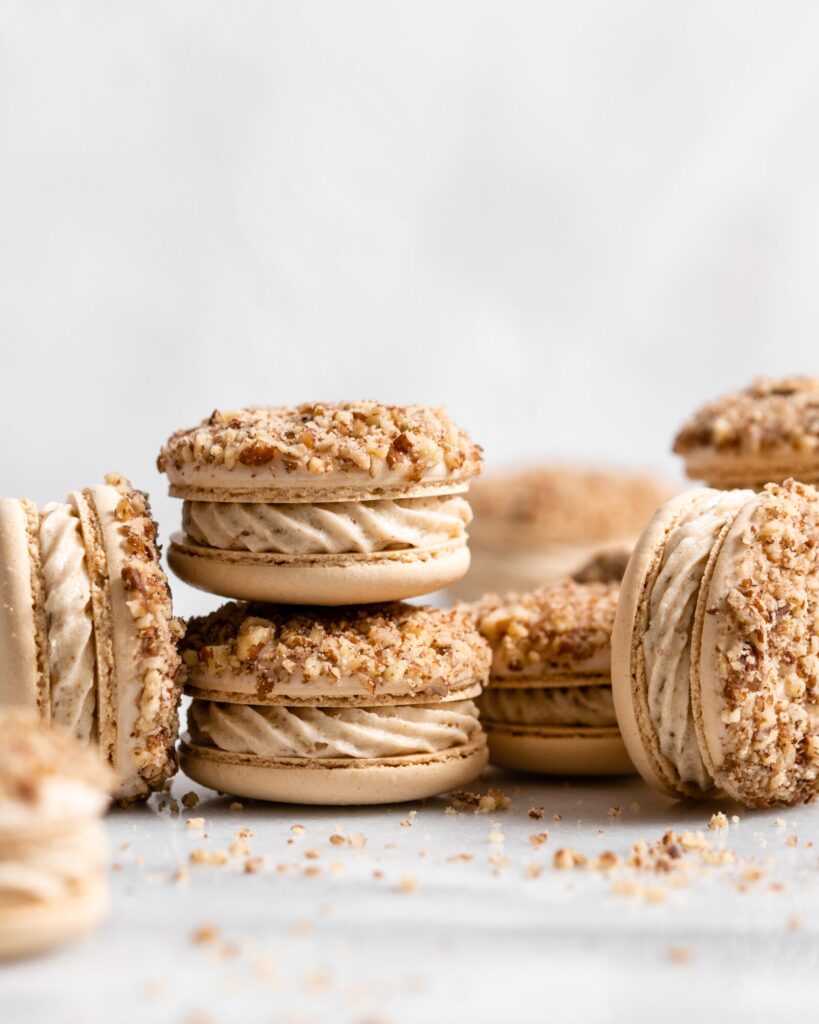
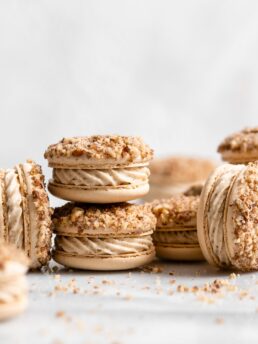
Get the Recipe: Maple Pecan Macarons
Ingredients
Maple Pecan Macarons
- 105 g Sifted Super Fine Almond Flour
- 105 g Sifted Confectioners Sugar
- 100 g Egg Whites
- 100 g White Sugar
- 3 g (1 tsp) Egg White Powder,, otherwise known as meringue powder (optional but highly recommended)
- 1 ½ tsp Maple Extract
Maple Pecan Buttercream Filling
- 1/2 cup Pecans
- 1/2 cup Unsalted Butter,, at room temperature
- 1 ¾ cups Confectioners Sugar
- 2 tbsp Maple Syrup
- 1 ½ tbsp Heavy Cream
- 1 tsp Maple Extract
Pecan Topping
- 1 cup Confectioners Sugar
- 3 tbsp Heavy Cream
- 1/2 cup Crushed or finely chopped Pecans
Equipment
- Stand mixer
Instructions
Dry Ingredients
- Prepare a baking sheet with parchment or silicone mat (if you have enough, prepare 2 baking sheets).
- Over a large mixing bowl on a scale, sift almond flour until you reach 105g. Discard any large pieces of almond flour. Repeat with the confectioners sugar. Whisk the almond flour and confectioners sugar until very well-combined. Set aside.
Making the Meringue
- Add egg whites, white sugar, and egg white powder to the bowl of your stand mixer, and whisk together. Place the bowl over top of a simmering pot of water (bain-marie), ensuring a tight seal and ensuring that the bottom of the stand mixer is not actually touching the water.
- Continuously whisk the mixture while it heats up over the bain-marie, heat the mixture until it reaches 140°F (60°C). When temperature is achieved, remove the bowl from the simmering water pot and place onto your stand mixer, fitted with the whip attachment.
- Beat the mixture, starting on low. Once soft peaks have been formed, increase the speed to medium. Once medium peaks are achieved, increase the speed to high. Beat on high until stiff peaks have formed. Add maple extract, then beat for 10 more seconds to incorporate.
Macaronage
- Remove the bowl from the stand mixer, and place a sieve over top. Pour the dry mixture from earlier into the sieve, then sift the dry ingredients into the meringue.
- Fold the dry ingredients into the meringue. I like to scrape around the sides of the bowl in an entire circle, and then cut through the centre – similar to the Greek letter phi which looks like this: Φ
- Be gentle and careful not to overmix or over-deflate the meringue. The mixture is ready to be piped when it ribbons off your spatula, meaning that the batter, when lifted with a spatula, should keep flowing off the spatula in ribbon shapes nonstop, without drizzling off too quickly. If it is coming off in large V shaped chunks it still needs to be folded further. Another test is the figure 8 test: If you can lift some batter up and use it to draw several figure 8’s without the stream breaking, it is ready!
Piping and Drying the Macarons
- Add mixture into a piping bag with medium to large sized round tip. Pipe small circles of batter onto a cookie sheet fitted with a silicone baking mat or parchment paper. Ensure piping bag is held straight up and perpendicular to baking sheet. Using a stencil or a macaron mat makes this process much easier and fool proof, I try to make my macarons around 1½” in diameter.
- Tap the baking sheet multiple times against counter to remove any air bubble from the macarons. If some air bubbles still remain, use a tooth pick to gently poke them out.
- Preheat oven to 300°F, or 275°F for convection oven. While oven is preheating, allow the macarons to sit and form a skin. This skin will ensure the macarons bake up and not out, giving them those classic “feet”. This skin should form anywhere from 8 minutes to an hour. You know the macarons are ready to be baked when you can touch them lightly without having the batter stick to your finger. Keep checking them to see if they have formed a skin– overly dried macarons are just as much of a problem as under-dried macarons!
Baking
- Bake for 15-20 minutes. Your bake time will depend on the size of your macarons. Check at 15 minutes, and if they are not ready then keep checking every minute. The macarons are ready when the tops are firm and do not move around their base at all.
- Allow the macarons to cool completely before attempting to remove them from the sheets/mats/parchment. When cooled, find “perfect pairs” of macaron halves and set aside to be filled and topped.
Maple Pecan Buttercream
- Place pecans into a food processor, then pulse until pecans are well-ground (just before paste begins to form). Set aside.
- Add butter to a stand mixer fitted with the whisk attachment. Beat on high until butter is doubled in volume, and looks light and fluffy.
- Turn the stand mixer to low and slowly add the confectioners sugar. Beat until completely incorporated, then add in the maple syrup, heavy cream, maple extract and ground pecans. Beat until well-combined and fully incorporated. Place buttercream into a piping bag fitted with a star tip.
Topping & Assembling the Macarons
- In a small mixing bowl, combine confectioners sugar and heavy cream (found under ‘Pecan Topping’ ingredients). Whisk until smooth. Dip ½ of the macaron shells (the tops of perfect pairs) into the glaze, then immediately dip into crushed pecans. Set aside to harden and set for 1-2 hours.
- After topping has set, pipe the maple buttercream onto the other ½ of the macaron shells (bottoms of perfect pairs), then top each bottom with it’s corresponding top. Place into the fridge overnight to mature and meld together.
Macaron shell recipe adapted from Pies and Tacos

